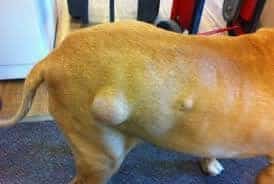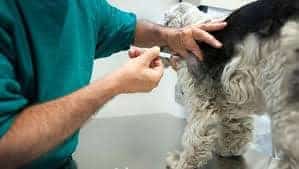Finding a lump or lumps on your pet is a disturbing event and definitely warrants a trip to the veterinarian’s office for an evaluation. Happily, it is not uncommon for the verdict to turn out to be “just a lipoma” or simply a “benign fatty tumor” and nothing to worry about. Still, the lipoma is not a condition that the general pet owner is likely to have heard of depending on their experience.

The Lipocyte (also Called the Adipocyte)
Fat is an important resource to our bodies. It is burned aerobically in times of steady exertion and in times of starvation, and provides insulation against the cold. Our bodies have a nearly unlimited capacity to store fat, which has led to an epidemic of obesity. Fat is stored within lipocytes, more commonly referred to as fat cells. The normal fat cell can enlarge spectacularly as it stores large amounts of fat.
The Lipoma
Any tissue can grow a tumor and fat tissue is no different. It is common for fat cells to form benign tumors called lipomas. The tumorous fat cell grows at a different rate from the surrounding fat tissue and accumulates more fat forming a lump.
Depending on how much fat the lipoma stores, the lump can be very large. If the pet is overweight to start with, the lipoma will be all the more obvious and all the larger; as the overweight pet loses weight, its lipomas will shrink though they are unlikely to completely go away.
The lipoma is benign meaning it does not invade other tissues or spread in a destructive way. Some dogs, however, develop multiple lipomas which can be very large and the fat deposits in any body area can potentially grow into a lipoma. Most lipomas are found under the skin or in muscle tissue rather than internally. Lipomas are mostly seen in dogs, particularly older over-weight dogs though cats occasionally are seen with lipomas.
How do we know it’s a Lipoma?

Should the Lipoma be Removed?
The lipoma has a fairly characteristic texture and is rubbery and relatively soft; however, it is probably not adequately accurate to make the diagnosis based on simply how a lump feels. A needle aspirate can be easily performed by withdrawing some cells from the mass with a syringe and looking for fat droplets on a microscope slide. This procedure is commonly performed and generally provides adequate results. Of course, if there is any question, the tissue can be biopsied for accuracy.
In most cases the problem is a cosmetic one. If the mass is unsightly, it can usually be removed provided that the patient has no health problems precluding anesthesia. In some cases, a large lipoma can grow in a location where it interferes with movement 0 such as under the armbits or the groin region. In these instances, removing the lipoma is probably a good idea. Often, lipomas are left alone if they do not seem to bother the patient. Surgical removal when they are smaller is usually easy as most lipomas can simply be peeled from out under the skin.
Malignant Lipoma
There is a version of the lipoma that is more invasive into other tissues and is more difficult to remove. This type of lipoma does not peel out, is not encapsulated, and does not have obvious borders. There is a 36% recurrence rate for this type of lipoma, whereas ordinary lipomas do not generally grow back.
Also, though it is rare, there is a malignant version of the lipoma called a liposarcoma. This is also a more infiltrative tumor though it does not generally spread through the body in the way we usually think of malignancy. A wide surgical excision is needed to control this type of fat tumor.
Please remember – all three types of lipoma (the regular, the more infiltrative, and the malignant form) will look the same when aspirated for fat cells during an office examination.
Look Alikes
There are a couple of malignant tumors that can mimic the rubbery nature of the lipoma. The mast cell tumor is a highly inflammatory and potentially very malignant growth of the skin and subcutaneous tissue. The needle aspirate of a mast cell tumor will look different from that of a lipoma so, in most cases, these can be distinguished during the initial office evaluation. The hemangiopericytoma is also rubbery like a lipoma and contains enough fat to confound the aspiration examination. In fact, several soft tissue sarcomas can be difficult to distinguish from a lipoma, though in most cases they seem subjectively more deeply rooted and firm. Biopsy may be needed to obtain a definitive answer and plan therapy in the event that a rubbery mass somehow doesn’t seem quite typical for a lipoma.
If you notice a lump on your pet, it is probably prudent to show your veterinarian. Most lumps require some sort of tissue sampling for diagnosis, though there may be a few that can be generally identified and monitored by visual inspection by the doctor. Since there is a potential for any lump to be a serious growth, it is important to take lumps and growths seriously have the doctor check them out.


